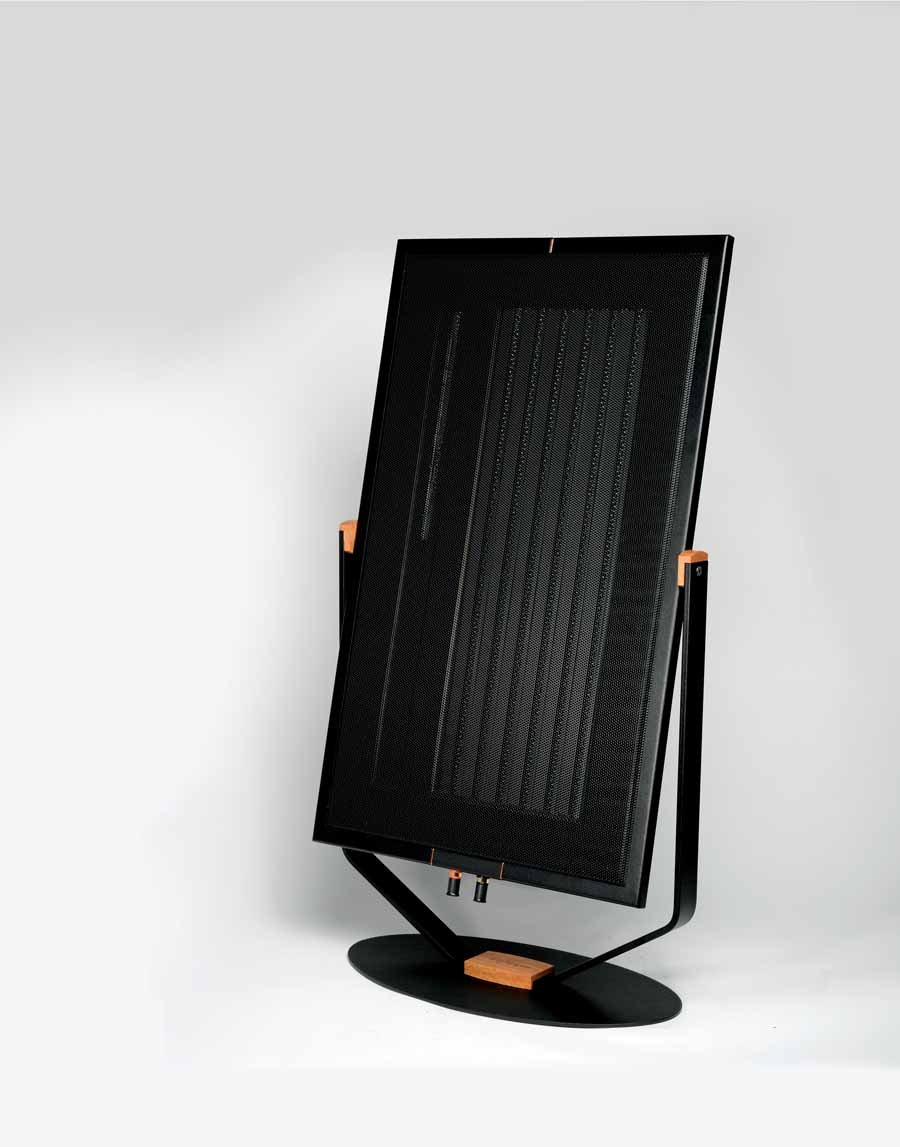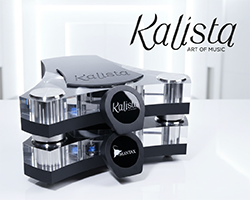Diptyque is a French loudspeaker manufacturer specialising in making Isodynamic panel  loudspeakers. In this review, Stuart Smith takes a look at their dp77 Anniversary model retailing at €3540.
loudspeakers. In this review, Stuart Smith takes a look at their dp77 Anniversary model retailing at €3540.

The Diptique d77s on their Anniversary Stands
Diptyque Audio is a partnership in France made up of Gilles Douziech and Eric Poix. Gilles spent time in his earlier years at an internship with Marcel Rochet, the designer of Mulidine Loudspeakers, and later continued his studies with another internship at LAMI, the acoustic laboratory based at the University of Toulouse. Later he carved out a successful career in medical electronics specialising in ultrasound, although during all this time he never stopped producing his own loudspeakers, culminating then in developing his first ribbon loudspeakers used to broadcast his artistic sound creations in contemporary art galleries. Eric on the other hand is an audiophile of twenty-five years standing and in this time has never stopped developing his system with scant regard for the current fashions in audio. It is Eric that is responsible for the mechanical structure of the Diptyques following his creation of his own speakers and supports for electronics. Eric is also responsible for the design of the sophisticated mechanical structure of the speakers that ensure the speakers’ membranes’ tension and rigidity are perfectly controlled.
All Diptyque loudspeakers are made in Montauban in the Occitanie region of France by hand where they are then subjected to both acoustic measurements and listening tests. The guys behind the brand have explored every loudspeaker technology, but after listening to all these they came to the conclusion that it is Isodynamic/Magnetostatic loudspeakers that they feel gives the most natural reproduction of sounds. Gilles and Eric say on their website that the benefits of this Isodynamic approach are:

A closeup of one of the side “arms” showing t protective oak detail
• Diffusion over a large area by a plane wave, which enables immersive listening without the sound projection effect.
• A dipole operation, on both sides of the speakers, to recreate the spatialization of the concert in your listening room.
• The use of extremely thin mylar membranes (12µm) for high speed and no drag effect.
• The same type of diaphragm used from low to high so everything operates at the same speed to provide consistency in dynamic behaviour across the sonic spectrum.
• No enclosure behind the speaker; there is no “box colouration” associated with cabinet bound loudspeakers.
• Consistent, balanced and detailed listening even at low levels.
• A regular impedance which does not represent a complex load on the amplifier.
• High reliability over time, not afraid of dust or humidity and they do not have a high voltage circuit.
So what is Isodynamic/Magnetostatic technology? Full disclosure – I had to look this up! So, if I get this right, Isodynamic speakers, first developed in the ‘70s in the States, use a planar concept much in the same way that an electrostatic loudspeaker, but instead of there being a coated plastic membrane between two plates with a charge they have very fine wire that is embedded into a membrane that moves between two magnets to create the movement. My only other experience of this kind of technology has been with planar headphones and so I’m somewhat intrigued by what the Diptyques will bring to the party.
The guys at Diptyque have further developed this technology and have several innovations/improvements over and above the broader concept. These are:
• PPBM®: Push-Pull Bipolar Magnet is an innovative patented architecture where large section bipolar magnets, manufactured to Diptyque’s specifications, are located at the front and rear of the membrane. They make it possible to maintain the coil (aluminium tapes) in a constant magnetic field when the membrane moves. Diptyque claim this makes the bass more dynamic and transient sounds are reproduced with precision.
• A Mechanical Sandwich Structure composed of the assembly of an MDF frame, fine felt and stamped sheets held in place by a welded steel frame. This makes for, Diptyque claim for a rigid structure without resonances and the absence of colouration.
• Proprietary ribbon tweeters. The tape is produced as an isodynamic cell (mylar film and aluminium coil). It moves in an intense magnetic field made from neodymium magnets. These tweeters operate over a wide frequency range and are designed to partner with the isodynamic cell that makes up the mid/bass cell . A gentle slope filtering (6 db per octave) is used in the crossover.
I caught up with Gilles Douziech to ask him a few questions about their brand and their speakers:
HP: This is an unusual design for a loudspeaker, can you explain what benefits this design, in your opinion, brings to the table?
GD: We, Eric and I, have been passionate about sound reproduction for over 30 years. We like isodynamic speakers for the absence of box colourations and the natural sound diffusion, but also the speed and consistency of the entire sound spectrum. Through our research we wanted to improve the qualities of these loudspeakers in the bass. For the design, we sought simplicity and efficiency.
HP: How specifically, and in your opinion, does your implementation of Isodynamic/Magnetostatic technology improve over the basic implementation?
GD: Our patented PPBM technology and our sandwich structure provide better control of low frequencies and transient sounds. The diptyque dp77 are small panels but they can reproduce dense and articulate bass and also have all the transparency and a wide soundstage of large Isodynamic speakers.
HP: There are numerous options in the choice of stands. Do they all perform equally or is there one that is better suited to the panels?
GD: The new support we have produced for the 10th anniversary of our brand is a tribute to the old microphones that were used to record the beautiful voices that still make us vibrate! Its rigid and heavy structure and the insulation by the pieces of wood improve the sound of the dp77.
HP: How important is the Made In France concept to you?
GD: What is important for us is to control all the manufacture of our speakers and not to depend on many subcontractors. All the elements of these speakers are manufactured in our workshops. We have invested in skills and machines to be free to create and manufacture. Only the painting is done outside and then by a company in our region. We train our employees to manufacture the entire loudspeaker, we pass on know-how, like luthiers. We thus guarantee the quality of the sound, and of the manufacturing.
HP: You have obviously thought about the aesthetics of the speakers with regards to them being available in lots of colours and being customisable with users’ photographs and artwork. Who do you see as being the typical customer for, specifically the dp77s?
GD: Our dp77 speakers have been designed for passionate music lovers who also love beautiful objects and architecture.
HP: What other speakers do you have in your range and do they all use similar technology to the dp77s?
GD: We currently have two other speakers, dp140 and dp160 models with different options. All of our speakers use the same technology. Music lovers can choose their model according to the size of the listening room. Our dp160 Activ Bass model integrates a solution with DSP amplifiers to adapt the bass curve according to the acoustics. We are working on new models that we will present at the High End show in Munich in September 2021.
BUILD AND FEATURES
The Diptyques arrived on a small palette in a relatively low profile box. Opening the box gives you the immediate impression that there has been a good deal of thought gone into the packaging – this is a good start! The panels themselves come in protective covers and the metalwork (a simple frame and stand) is cable tied to a specially made frame for transport – this frame is actually cut out from the waste MDF from when the panels are cut and so zero waste. There is a very logical instruction pamphlet, and putting the speakers together is simple as can be that involves screwing two screws to attach the frame to the panels, and two more to attach the frame to the base. It took me about five minutes from unpacking to having the speakers fully assembled and plumbed into the system.

The Bottom Of The dp77s Showing The Binding Posts and Diptiqye Oak Detail Used to Cover the Two Screws connecting the bottom support plate
First of all, there is no denying that these are a really beautiful looking speaker, and whilst being big in surface area, they are thin and easy to position in the room. The frame allows you to change the vertical angle of the main panel so you can play with what positioning works best for you. A nice touch is the little wooden doodads to both protect the frames’ finish and to hide the screws in the base. A single pair of speaker binding posts are positioned centre at the bottom of each of the loudspeakers’ panel, which is itself a couple of CM thick. That’s about it and there’s not much more to say about the look of the dp77s.
Specifically, the dp77s use a 0.1232m2 bass/midrange ‘panel’ and a 30cm high ribbon tweeter. They are a 2-way design with a sensitivity of 84db and impedance of 6Ohms. Quoted frequency response is 50 – 19000Hz and Diptyque recommends amps with a minimum of 60W, but preferably 150W and above – I used our Merrill Thor amps which are more than capable in this respect. The actual panel measures 770 x 470 x 20mm and weighs 11kg, though with the base etc comes in at 18Kg.

An example of one of the art panels
The dp77 are supplied as flat panels with no feet and you choose the finish and legs thereafter via their online shop. The panels in standard finish are €2860 and £3240 in one of 184 RAL colours. You then choose your legs – you can have the Anniversary Legs in Black Steel and Oak (as supplied here) at €680, or the less expensive Finnish Birch legs at €300, or transparent PMMA at €540. For an extra €80 each (€160 per pair) you can have custom made skins made from your photos for these speakers, which is really rather cool and means they will fit into any environment and become a sonic piece of art. I like this idea…a LOT!
SOUND
These arrived and got set up in the upstairs mid-priced system and I just put on the CD that was in the drawer from my last listening session, Hot Chip’s Made In The Dark, and the first thing that hit me was the bass. It just didn’t seem right that these panels seemed to go so low, and it was only later I read that they are supposed to go down only to 50Hz, it certainly seems lower than that, or perhaps it’s that they are in a room that is relevant to their size. I’m going to review the dp77s without a subwoofer in place but may well put our pair of RELs in the system just for a bit of fun towards the end of the review process.
There are no instructions about whether to set the dp77s with the tweeter panel on the inside or outside and so I had a bit of a play and found that, despite how I’d originally had them set up, they sound best with the tweeter’s on the outer edge of the panels – that is to the far left on the left speaker and conversely on the right-hand speaker. Likewise, you can alter the angle that you set them up at vertically and I originally had them pointing upwards towards my head when sat down. However, I found the soundstage seemed more accurate with the speakers having no angle at all and flat with regards to their frame. Likewise, with the tweeter being on the outer of the panel, I found the soundstage to be a little wider. The great thing is you can experiment really easily with their angles without having to lug the speakers about, even swapping them from one side to the other was a couple of minutes job.

A brace of Diptique d77s
Regular readers will know that, as a rule, I tend to listen pretty loud, but I started off with these speakers listening to Jefferson Airplane’s Crown Of Creation, specifically the third track, Triad (a David Crosby Number) at a very low volume…for me. This has Grace Slick’s voice sounding as smooth as cream, and there is a really good awareness of her singing style that really shines through – a slight vibrato on notes that are held for longer periods is very evident and clear with these speakers in place. The lazy taps on the cymbals come through the mix really well, and even at these very low volumes, I feel like I’m getting a complete picture of the recording, right down to fingers moving on the strings and fretboard of the guitar. A lot of loudspeakers really lose it at low volumes and you are left with just a vague impression of the recording. The separation of instruments is clear and it is obvious where individual instruments are panned on the desk. On the title track, the fuzzy bass is presented absolutely majestically; of course, there isn’t the weight you get at higher volumes, but I genuinely don’t feel I’m missing any detail or timbre of instruments and voices.
Time for a bit of a change of style and pace with the vinyl copy of Channel One Pressure Sounds 55. I crank the volume up a bit but not too silly volume (well easy enough to have a conversation over…ish). Of course, it is the pounding and relentless bass that defines dub reggae and I don’t think there’s anything missing here, even at this modest volume the dp77s do a great job on the opening track Kunta Kinte – keep in mind I haven’t added the subs to the equation as yet, and I don’t feel the need to. Likewise, on track two (Hotter Fire Version), the bass underpins the whole tune, and, whilst it is prominent in the mix, it doesn’t overpower the presentation the Diptyques offer up. The HUGE reverb hits are well evident and decay as they should into the background. I’ll be quite frank here and say that I’m a bit overwhelmed at how these unassuming panels handle this material – pleasantly overwhelmed. One thing I did notice here – I’m sitting slightly off-axis as we have two listening seats side by side in this listening space, and it becomes clear that there is a definite sweet spot with regards to these loudspeakers. However, I get up, toe in the right-hand speaker a little, and all is well with everything snapping into place.

The panel can be easily angled to suit owners’ preferences
Snowpatrol’s Eyes Open is up next and the opening track You’re All I Have comes on before I can get back to my seat. It sounds a bit muddy walking back to my seat, but as soon as I sit down everything just feels right again – you do need to be sat down between these speakers to get the best from them, but that really shouldn’t be a surprise to anyone. I didn’t pull this record out for this track, I pulled it off the shelf for Open Your Eyes, but end up playing The Finish Line beforehand and that bass is strikingly portrayed and really energises this very well damped room – very impressive indeed. The track I was looking for begins pretty gently with voice and a guitar and it sounds as it should here, but when that bass drum kick comes in I’m really feeling it. It’s not too much and the whole is very well balanced, the vocal being nicely projected forward into the room. When the track breaks, if you know the tune you’ll know when I mean, the room is filled with sound and I do actually find myself turning it down a tad.
Nirvana’s Smells Like Teen Spirit is on next and it becomes clear that there is a volume at which the Diptyques become uncomfortable – but that is VERY loud and to be fair to them, I don’t think folk would listen so loud. I also imagine the volume is too much for this room! I grab an app for the phone and it tells me I’m listening at around 80dB and much above this is where it starts to get a little much, but to be absolutely fair I can’t listen at that high a volume for very long. What is clear is that the speakers are incredibly fast, dealing with changes in volume and dynamics absolutely splendidly. Interestingly, I was reading one of the Facebook groups’ questionnaires that asked its members what they looked for in a system, and dynamics was one consistent feature – the dp77’s certainly do dynamics wonderfully. I also love that there is NO bass lag/overhang/bloat – call it what you will – and regular readers will know bass bloat is a major bugbear of mine.
Right, I’m going to tune in the subs by way of experimentation, but, in this room, I don’t really think the dp77s need them at all. And I’m right, to an extent. Yes, a pair of subs fill out the lowest of the low frequencies that the dp77s are missing, but I found I really had to rein the subs right in to get them right. Playing the same Studio 1 tracks I played earlier, what I found the subs brought to the party was an ability to listen to the db77s more quietly and still experience them at their best (the sound meter app reckons and an average of 75dB.) I also felt that adding the subs sharpened the soundstage a little more – I don’t understand or know why and can only tell you what I experienced! Do the dp77s need subs? – I don’t think so, but they do add a bit more weight to proceedings.

Full frontal shot of a single dp77 loudspeaker
I’m just typing up my notes and I’ve got Jorma Kaukonen’s Quah playing. I’m not really listening, but the track Blue Prelude comes on and makes me look up from my keyboard. His guitar sounds utterly lifelike and ‘in the room’. I know that sounds like reviewer claptrap (no, really, I am fully aware!) but that’s what I got from it and it really did draw me in, stop me in my (typing tracks) and I was mesmerised. I listen to this album a LOT and the track Genesis is one of my all-time favourites but I’m not sure I’ve heard it sound better! Unfortunately, the Diptyques couldn’t make the track Sweet Hawaiian Sunshine sound anything but lyrically dire.
CONCLUSION
These are a very good loudspeaker indeed. They can do delicate and restrained when they need to but they really can rock out too. They certainly have an upper limit with regards to volume where they become a little uncomfortable. However, one of the big selling points of the dp77s is that they play really beautifully at lower and more realistic listening levels.
On the bass front (Nirvana’s Breed’s bass line is a brilliant case in point) the Diptyques are fast, articulate, and wonderfully impactful. Nothing on the bass front phases them, and I expected this to be their Achilles Heel. Dub, rock, electro, techno – nothing gives them grief. Adding a pair of subs does add a little more weight and does something to the imaging, though I can’t explain why. I certainly didn’t think I would be, but I played a LOT of dub through these speakers and loved the way the bass was portrayed.
On the soundstage front, I think that the dp77s present a good forward to back image, but left to right the image is certainly mostly between the speakers. There is also good height to the image presented.
Detail from these speakers is phenomenally good, but they also feel very natural sounding – almost as if they aren’t having to try too hard – they never (unless pushed too hard), lose control. Keep them within their limits and they are wonderful! I would have loved to have been able to partner them with our Krell amplifier, but sadly that is in hospital in America having major surgery.
Do they prefer a particular style of music? I don’t think so, and I threw a whole lot of stuff at them to get them flustered and hot under the collar. Only when pushed too hard so they get a bit much, but that’s par for the course for any speaker, in my experience.
I loved these speakers and don’t hesitate for one moment recommending you get yourself a listen. I posted a video up on Facebook and someone messaged that the Diptyques were one of the speakers they were really looking forward to hearing at the rearranged Munich High End show later in the year…fingers crossed!
Truly deserving of our highest award!
AT A GLANCE
Build Quality: Very nicely put together and well thought out. The packaging is a joy and they are a doddle to assemble. Visually they look great in black but you can get all funky with RAL colours and special covers for them made from your photographs. The metal and oak stand suits the dp77s perfectly and makes for an elegant looking loudspeaker that is interesting without being hyper-imposing.
Sound Quality: Speed and dynamics are the dp77s strong points. That bass is wonderfully speedy and this played to my personal preferences in a loudspeaker. Adding a pair of subs adds a little but in a reasonably sized room you certainly don’t need them. They aren’t particularly bothered about placement but there is a definite ‘hot spot’ with them, however, I found toeing in the far speaker a little sorted this, no bother. At low volumes they really do excel and this is an area where other speakers can fall down. Push them too loud for the room and they can get a bit much – but that was pushing them VERY hard indeed.
Value For Money: The Diptyques arrived and I had forgotten the price as it was months since we’d first arranged a review. I set them up, popped in a few tunes and we played guess the price. I guessed 7/8K and was very surprised they came in at three and a bit grand Euros once Linette had done an internet search.
Pros:
Wonderfully informative
Fast and articulate bass that goes low beyond what I expected
Keep the same character even at very low volumes
Dynamic and ‘clean’ sounding
Very low colouration
Easy to position and move about to get the best image for your position
Great looking and customisable
I believe them to be very good value for money
Cons:
When pushed too hard things get a bit much and confused…but that’s like any speaker, really
There is a definite sweet spot

Stuart Smith
Review Equipment: Technics 1200G, Audio Technica AT0C9 cartridge, Hegel Phonostage. Lab12 Pre amp and Merril Thor amps. Lab12 dac1 DAC and Leema Elements CD player. Lab12 gordian power conditioner and Atlas cables. Subs by REL.



















































































































































































































You must be logged in to leave a reply.